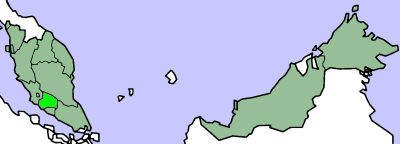Negeri Sembilan is a state in the west coast region of Peninsular Malaysia.
Cities
[edit]Other destinations
[edit]Understand
[edit]
The state's name, Negeri Sembilan, literally means "Nine States" in Malay but actually is believed to refer to nine different villages in which Minangkabau settled in the 19th century (the Minangkabau word for village being nagari). The state's system of government is unique, as a state-based constitutional monarchy with an elected ruler. Somewhat confusingly, Negeri Sembilan has not nine but seven districts, and only four of them are represented by local rulers called Undang, who also has the power to vote for the overall ruler of the state, called the Yang di-Pertuan Besar (roughly translatable as "Big Ruler").
The Minangkabau came in large numbers from their homeland in West Sumatra in the 19th century and today constitute the majority of the Malay population in Negeri Sembilan. Their traditional architectural style influences much of the public architecture in the state, and their cuisine (notably including nasi Padang) is particularly popular here. A diverse state, Negeri Sembilan also has many citizens of Chinese origin, whose ancestors were invited in by local rulers and then the British overlords in order to work the tin mines, starting in the 19th century. A somewhat smaller Indian population, likewise, includes many descendants of labourers who worked the rubber plantations in colonial Malaya.
Talk
[edit]Negeri Sembilan is a state that can trace its roots to the Minangkabau heritage which originated from Indonesia. However, just about everyone can understand and speak standard Malay. English is also fairly widely spoken as a second language. The main language among the ethnic Chinese community is Cantonese, though there is also a significant Hakka-speaking minority, most of whom are able to speak Cantonese as well. Most ethnic Chinese also speak Mandarin as it is the medium of instruction schools catering to that community.
Get in
[edit]By plane
[edit]Negeri Sembilan does not have an airport. However, the Kuala Lumpur International Airport in Sepang, Selangor is not too far from the state and there are direct bus connections with Seremban.
By road
[edit]Negeri Sembilan is located approximately 60 km to the south of Kuala Lumpur via the North-South Expressway (Lebuhraya Utara Selatan) and only 40 km from the Kuala Lumpur International Airport (KLIA). From the airport, various taxi, bus and private car connections are available. There are also air-conditioned bus services which ply the Kuala Lumpur-Seremban route from Puduraya Bus Terminal in Kuala Lumpur.
By train
[edit]Negeri Sembilan is accessible from Singapore via KTM (Keretapi Tanah Melayu) interstate train service, which has two stops in the state, at Tampin and Seremban. From Kuala Lumpur, you can take the komuter [sic: Malay spelling] train at KL Sentral station to Seremban.
By boat
[edit]There are ferry connections between Port Dickson and Dumai in Riau province of Sumatra, Indonesia.
Get around
[edit]See
[edit]
- Museum Adat
- Muzium DiRaja Sri Menanti (The Royal Museum of Sri Menanti)
- Hutan Lipur Ulu Bendol (Lipur Ulu Bendol Forest)
- Pedas Hot Springs
- Ulu Bendul Waterfalls
- Seri Menanti Royal Palace
Do
[edit]Eat
[edit]Sleep
[edit]Stay safe
[edit]Go next
[edit]- Melaka, 1 hour away from here
- Kuala Lumpur, at least 30 to 45 minutes away from here
- Genting Highlands, Malaysia's famous hill resort, which is at least 1.5 to 2 hours away from here



